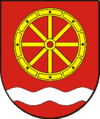Koło
| Koło | |||
|---|---|---|---|
|
Street in Old Town | |||
| |||
 Koło | |||
| Coordinates: 52°12′N 18°38′E / 52.200°N 18.633°E | |||
| Country |
| ||
| Voivodeship | Greater Poland | ||
| County | Koło County | ||
| Gmina | Koło (urban gmina) | ||
| Established | 13th century | ||
| Town rights | 1362 | ||
| Government | |||
| • Mayor | Stanisław Maciaszek (PiS) | ||
| Area | |||
| • Total | 13.85 km2 (5.35 sq mi) | ||
| Elevation | 110 m (360 ft) | ||
| Population (2006) | |||
| • Total | 23,034 | ||
| • Density | 1,700/km2 (4,300/sq mi) | ||
| Time zone | CET (UTC+1) | ||
| • Summer (DST) | CEST (UTC+2) | ||
| Postal code | 62-600 to 62-602 | ||
| Area code(s) | +48 63 | ||
| Climate | Dfb | ||
| Car plates | PKL | ||
| Website | http://www.kolo.pl | ||
Koło pronounced [ˈkɔwɔ] (German: Wartbrücken (1940-41), Warthbrücken (1941-45)) is a town on the Warta River in central Poland with 23,101 inhabitants (2006). It is situated in the Greater Poland Voivodship (since 1999), having previously been in Konin Voivodship (1975–1998), and it is the capital of Koło County.[1]
History
Koło is one of the oldest towns in Poland. It was granted town status in 1362 by King Casimir III.[2] It was situated in a safe place near the royal castle, on the island in the branches of the Warta River; the town had no walls but only two gates. It was a royal city and the seat of a land county (starostwo niegrodowe).[1][p. 16–18]
In 1410 Koło was a gathering place of the Greater Poland nobility, which called for a war with the Teutonic Order (see Battle of Grunwald). In 1452 the Royal Castle in Koło was the place of meeting between King Casimir the Jagiellonian and the representatives of the Prussian Union (see: the Thirteen Years' War).
From the early 15th century until 1716, Koło was the meeting place of the Provincial Parliament called Sejmik Generalny for the Greater Poland region, comprising the Poznań Voivodship, Kalisz, Sieradz, Łęczyca, Brześć Kujawski and Inowrocław Voivodeships. The town evolved into a regional hub of trade and crafts especially in metals and textiles, and as a centre of pottery. In 1571 a contract was drafted with regard to the status of the Jews in Koło, in which the city's Christians have undertaken to provide protection to the Jews, in return for which the Jews were required pay a special annual municipal tax.[3]
Koło was destroyed twice, once in 1622 by the Lisowski forces, and in 1655 by the Swedes; the economy managed to revive only at the end of the 17th century. Until 1793 Koło belonged to Konin County of Kalisz Voivodeship. Following the partitions of Poland, in the years 1793-1806 it was occupied by Prussia, but during the Kościuszko insurrection in 1794 it was temporarily liberated by the insurgents. In the years 1807-1815 it belonged to the Duchy of Warsaw and later to Congress Poland.
Modern era
After the return of Poland's sovereignty at the end of World War I, Koło was assigned to Łódź Voivodeship. A new railway line opened in 1921 from Kutno to Strzałkowo via Koło. In the early 20th century, the Jewish population of Koło made up almost 50 percent of the total population. When Nazi Germany invaded Poland, they captured Koło on September 18, 1939. On September 19, Jewish males over the age of 14 were rounded up and sent to forced labor. The Jewish synagogue was set on fire the following day.[4]
The first Aktion, conducted by Wehrmacht soldiers and gendarmes, took place in December 1939, in which 100 Jews were executed.[5] In December 1940, the Jews were rounded up in a ghetto, which was liquidated the following year, in December 1941.[6] The remaining Jews were deported to Chełmno extermination camp, where they were killed in gas vans and buried in mass graves. Koło remained a transfer point for Jews deported to Łódź, and Nazi officials, including Heinrich Himmler, visited the town.[3][7]
Sports
- Olimpia Koło - football team (3rd league 1960, 1963–1965)
Notable residents
- Franciszek Ksawery Dmochowski - novelist, poet, translator, publisher, critic, and satirist
- Tomasz Kos - football player (FC Erzgebirge Aue)
- Jan Pusty - retired hurdler
- Aron Brand - pediatric cardiologist
- George Chapman (murderer) - serial killer
International relations
Twin towns — Sister cities
Koło is twinned with:
| Wikimedia Commons has media related to Koło. |
References
- 1 2 U.M.K. (2014). "KOŁO 2005: Ludność. Położenie geograficzne. Klimat. Dziedzictwo kulturowe" (PDF). Zaącznik do Uchwały nr XXXVIII / 269 / 2005 Rady Miejskiej w Kole z dnia 28 czerwca 2005 roku. Urząd Miejski w Kole. Retrieved 17 May 2014.
- ↑ "Koło" - Encyclopedia of Jewish Communities in Poland, Volume I
- 1 2 Mahler, Rafael. "From the near and far past". Some information about the history of the Jews of Koło.
- ↑ Dates of grief. Sefer Koło; Funfhundert yor Yiddish Kolo. 1958. Mordekhai Halter (ed.) p. 335.
- ↑ "Execution Sites of Jewish Victims Investigated by Yahad-In Unum". Yahad Map. Retrieved 18 December 2014.
- ↑ International Jewish Cemetery Project
- ↑ Kolo (Muhlental), Poland
External links
Coordinates: 52°12′N 18°39′E / 52.200°N 18.650°E




